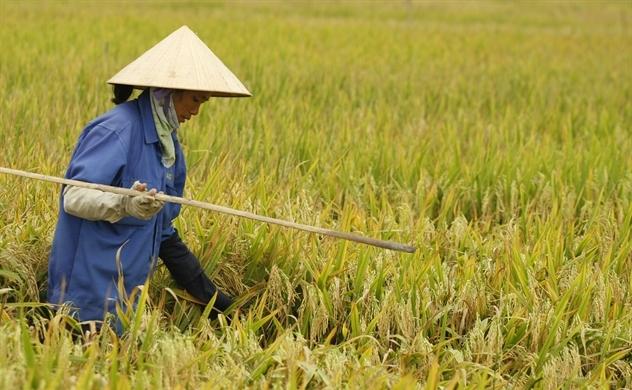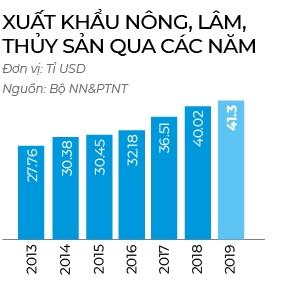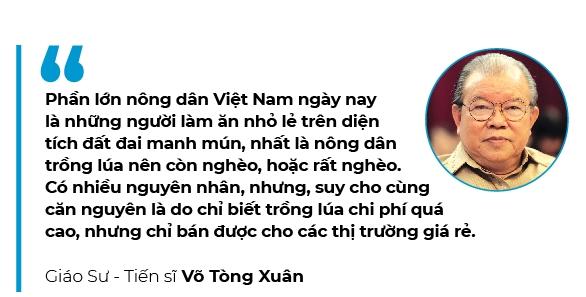
Large fields require capital accumulation and investment in technology and equipment… which ordinary farmers cannot afford on their own. Photo: Quy Hoa
Agricultural industrialization
No major population power has prospered from agriculture. While per capita income is still low, high-priced agricultural products can impoverish the country, creating opportunities for imported agricultural products to dominate the market when technical barriers or protectionist policies cannot be applied.
In developed economies, in terms of capital intensity, the roles of the processing, manufacturing, and agricultural industries are interchangeable. Capital intensity in the small agricultural sector is much higher than in the processing and manufacturing industry. This is related to "agricultural industrialization" - the process of increasing agricultural productivity, improving the competitiveness of agricultural products and increasing farmers' incomes.

When capital and machine content increases, labor intensity decreases. Agricultural labor is currently less than 3% of the total population of the United States, but production of this country is the world's leading export. Meanwhile, urbanization in Vietnam currently is only over 30%, most of the population still lives in rural areas and agriculture is still fragmented and labor intensive.
Agricultural industrialization is an expensive and risky investment that requires practical strategic steps under the close observation of competing countries in the region and the world.
Agriculture has become much more efficient thanks to the application of capital-intensive technologies such as greenhouse farming, concentrated husbandry using integrated technologies… Large area fields require capital accumulation and investment in technology and equipment... that the farmers could not afford without the leading policy of the state and the participation of private agricultural corporations.
The agricultural economic transformation will only be successful when it achieves two main goals: increasing output value and reducing input costs. In fact, most of Vietnam's agricultural products are traded as raw materials at lower prices than other countries due to inferior quality and a number of other reasons. To put it bluntly, agricultural output growth is achieved by using more and more inputs at a greater negative cost to the environment. Without radical change, we will not be able to take advantage of opportunities even though Vietnam is the country that signs the most FTAs in the region.
The policy must reach farmers
To do so, the land policy must be reformed. Then invest in renovating and regenerating land, water and air. Supportive market policies, price subsidies, government costs and priority financing policies for the agricultural sector are essential. No country, even if it is rich, does not have a special protection policy for domestic agriculture.
In addition, and most importantly, in order for farmers to get out of poverty sustainably (according to the standards of each period and each country), first of all, successful industrialization and urbanization must be achieved. In the future, in a developed economy, the contribution of agriculture to GDP will have to give way to industry and high-quality services. As productivity increases and labor decreases, the rate of profit will therefore increase, benefiting farmers.

The problem is, how to effectively support policies, reaching the right farmers as protective nets for the income of farming, which is always precarious and risky. Agricultural support policies must go directly to farmers, not to the beneficiaries who are traders and businesses
Rice production has increased, and exports have also increased, but the income and life of farmers in general are still very hard. Price squeeze on farmers is really just the surface of a more complex economic phenomenon. Even if the world rice price has increased in recent days, it is not certain that farmers are the beneficiaries. In fact, traders and exporters benefit most from the increase in agricultural prices, while farmers enjoy a very small share.
The total capacity of rice storage in the Mekong Delta is more than 5 million tons of rice, which is good in theory, and sufficient for storage to meet national food security needs. But the rice stockpile accounts for the majority, which means that farmers will not benefit much from the government's policies to support the purchase and storage of rice at market prices, but traders and businesses are the beneficiaries because farmers sold fresh rice to traders.

Harvesting rice in Can Tho. Photo: Quy Hoa
To develop agriculture, it is necessary to attract young people to the fields. Large area fields require large investments, and whether the farmers can afford and has the capital to continue with the work that requires both modern farming skills and the trade, or whether they work as hired laborers / workers for large enterprises on their own fields.
Free trade can bring opportunities for some people, countries with more powerful potential. But free trade can also hurt farmers who are urged to abandon their fields to grow crops for export. For many enterprises, natural energy is only an economic source. When a locality is exhausted, they will move to another place, the farmers will be helpless. Farming can give life-changing opportunities, being a worker can't. It is necessary to invest heavily in education for the younger generations to work in agriculture, so that they will enrich themselves better on the land of their ancestors.
Source: nhipcaudautu.vn